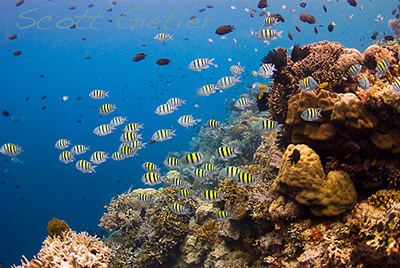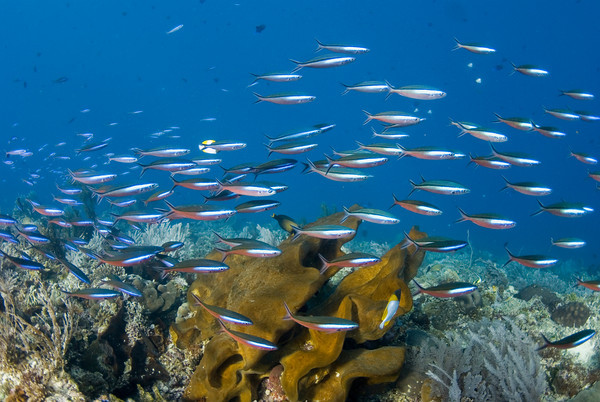Underwater Photography Basics

Important Underwater Photography Facts
Water absorbs colors such as red, orange, and yellow. This is why your underwater photos will look blue if you don't use a flash or strobe. The deeper you are, the more color is absorbed.
Compact cameras come with internal flashes that can be used to add colors to your photos
Underwater photographers often buy an external strobe / flash as a way to add color
Water reduces contrast, color and sharpness, which is why underwater photos should be taken within 1 meter of the camera, preferably much closer. You need to get very close to your subject.
Underwater Photography Definitions
Strobe or Flash - a source of full-spectrum light vital to underwater photographers. This can be built into the camera, or supplied as an external light.
Underwater Housing - also known as an underwater casing, this allows you to take a camera underwater and operate the camera. Housings can cost anywhere from $100 to $5,000.
O-ring - a rubber ring that creates a waterproof seal. Underwater housings and strobes will have several o-rings making them waterproof.
Macro lens - a lens attached to either the camera or underwater housing, that allows an underwater photographer to get very close to small subjects.
Wide-angle lens- a lens attached to either the camera or underwater housing, that allows a very close approach to large subjects. Without a wide-angle lens, underwater photographs of large subjects have poor color and contrast.
Shooting macro - dedicating a dive moving slowly, looking for small subjects, often with a macro lens.
Shooting wide-angle - dedicating a dive to photographing large subjects, often with a wide-angle lens.
Ambient light - also known as natural light, this is light from the sun. Underwater photographs are often a mix of ambient light and strobe light.
White balance - a setting on cameras telling the camera processor how to interpret pixel values it records when taking a photograph.
Manual White balance - also known as Custom white balance, a setting on most cameras that will give your photos more natural colors when not using a flash.
Backscatter - specks, spots or blotches that appear in your underwater photos due to strobe light reflecting off particles, sand or plankton in the water.
TTL - technology that automatically sets the power of your strobe/flash to the correct value.
Fiber Optic cable - a simple cable that can transmit light that will synchronize the firing of your strobe or flash with your camera.
Shooting manual - a phrase that implies you are either setting the camera aperture and shutter speed values yourself, or setting your strobe power yourself.
More Underwater Photography Basics
Using a flash or strobe in underwater photography is very important. Put your camera in forced-flash mode when taking close-up photos. Buying an external strobe is the best way to improve your underwater photos.
If using an internal flash, don't be surprised if your photos have backscatter in them. At first you might think it's dust or dirt on your lens. This is due to particles in the water.
Try getting low and shooting at eye level with your subject, instead of photographing them from above.
Get your buoyancy and diving skills down before taking a camera underwater.
Use auto white-balance when using a flash/strobe, and custom white balance or underwater mode when not using a flash
Learn how to use manual mode or aperture priority mode if your camera offers it, so you control the balance between the natural light and the light from your flash
Thank you for reviewing the underwater photography basics, and I hope you find the following articles helpful.
Further Reading
Beginner's Guide to Underwater Photography
Beginner's Guide to Underwater Composition


RECOMMENDED ARTICLES
SUPPORT THE UNDERWATER PHOTOGRAPHY GUIDE:
The Best Service & Prices on u/w Photo Gear
 Visit Bluewater Photo & Video for all your underwater photography and video gear. Click, or call the team at (310) 633-5052 for expert advice!
Visit Bluewater Photo & Video for all your underwater photography and video gear. Click, or call the team at (310) 633-5052 for expert advice!
The Best Pricing, Service & Expert Advice to Book your Dive Trips
 Bluewater Travel is your full-service scuba travel agency. Let our expert advisers plan and book your next dive vacation. Run by divers, for divers.
Bluewater Travel is your full-service scuba travel agency. Let our expert advisers plan and book your next dive vacation. Run by divers, for divers.










































